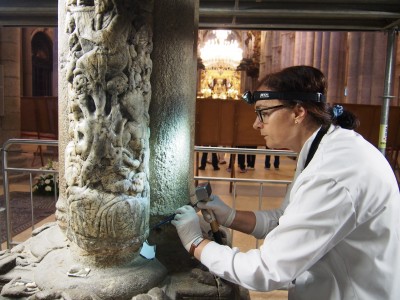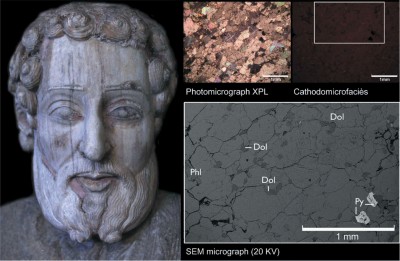
The ICAC participates in a multidisciplinary and comprehensive study of the unique five marble elements used in the famous Portico of Glory, European medieval sculpture masterpiece made by Master Mateo between 1168 and 1188, and part of the Romanesque front of the Santiago de Compostela Cathedral, declared UNESCO World Heritage Site in 1985.
The composition consists in four columns and the head of one of the apostles –traditionally identified as Andre the Apostle– that stand out in a set made of granite but decorated with the noblest materials (lapis lazuli, vermilion, gold and silver, among others).
Contrary to what had been traditionally assumed, the study confirms two different types of marble used in the elaboration of these elements:
- Marble of the Anticlinal de Estremoz (Alentejo, in the southern part of Portugal), for the three twisted columns, integrated into the pillars and mullion of the central arch.
- Local marble, for the fourth column and the head of the apostle, located in visually less central points.
By means of comparing these results with the written documentation on the construction of the cathedral, the study reveals a greater complexity in the use of marble at the north-western area of the Iberian Peninsula at this time, either by Roman spolia or the exploitation of the own resources.

Materials analysis blended different techniques (polarized light optical microscopy, cathodoluminescence, X-ray diffraction, scanning electron microscopy and IRMS mass spectrometry).
Marbles’ origin identification came from the comparison with geological samples of the reference collections located at the ICAC’s Archaeometric Studies Unit, the LEMLA, Laboratory for the study of the slippery materials in antiquity (Autonomous University of Barcelona) and the Department of Earth Sciences (University of Zaragoza), besides the currently available reference databases.
The results of the study have been published in an impact paper in the International Journal of Architectural Heritage (Q1, impact factor 1,78) DOI: 10.1080/15583058.2019.1602683
(2019)
The research team was led by Dr Pilar Lapuente Mercadal (University of Zaragoza, and fellow researcher at the ICAC, member of the research group ArPa), with the participation of Dr Anna Gutiérrez Garcia-M. (ICAC), and had researchers from Galicia, Madrid and Bordeaux (France) thanks to the collaboration with different international research centres:
- Institut de Recherche sur les ArchéoMATériaux (IRAMAT) – Centre de Recherche en Physique Appliquée à l’Archéologie (CRP2A), University of Bordeaux Montaigne – UMR 5060 CNRS (France).
- Gupo de Estudos de Arqueoloxía, Antigüedade e Territorio (GEAAT), University of Vigo (Spain).
- MIAS, Madrid Institute for Advanced Studies, Autonomous University of Madrid (Spain).
- Cultural Heritage Institute of Spain.
This initiative has been a meeting point for on-going projects Program Cathedral of Santiago, which works since 2006 in the restoration and preservation of this world heritage masterpiece, and Marmora Galicia project, which is part of different interdisciplinary research projects led by the ICAC. This is another example of the joint work and commitment, both public and private institutions, and academic ones, with the conservation and dissemination of historical and cultural heritage.
Program Cathedral of Santiago is funded by the Barrié Foundation and several national and international institutions: Cabildo de la Catedral & Arzobispado de Santiago, Andrew W. Mellon Foundation, Real Colegio Complutense in Harvard, Cultural Heritage Institute of Spain and Xunta de Galicia. The Project for the conservation and restoration of the Portal of Glory and its environment has received many different awards, including the European Heritage Award/ Europa Nostra Award 2019 in the Conservation Category.
The Marmora Galicia project is been carried out under different research projects lead by the ICAC (HAR2011-25011 y HAR2015-65319-P MICINN/FEDER) and participated by the Laboratoire Sciences Archéologiques de Bordeaux (nº ANR-10-LABX-52, projects Mamor et lapides Hispaniae… and “Graver dans le marbre”-ROMAE), with the double aim of creating a database of existing marble lithotypes in NW of Hispania and identifying the origin of the marble pieces documented in this territory.





